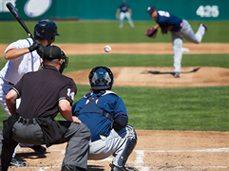
Sports Vision Training consists of the learning and training of Dynamic Visual Skills – that is “Vision in Motion”. These skills include Accommodation and Convergence, Anticipation Timing, Concentration under Stress, Depth Perception, Eye-Hand Coordination, Peripheral Awareness, Speed and Span of Recognition and Visual Reaction Time (or Initiation Speed).
The following is an explanation of the most relevant dynamic visual skills associated with baseball. These are all learned skills that can be improved with practice.

Alignment can impact your perception of where the ball is in free space and subsequently impact the timing of your actions. If the eyes aim in front of the ball, this can result in an early swing, a ball thrown short or a glove placed in front of the ball; if the eyes aim behind the ball, this can result in a late swing, a ball being overthrown or a glove placed too far forward. In both cases, the athletes will probably exhibit inconsistent performances.
Focusing flexibility and eye-tracking ... that ability to keep both eyes working in unison as they track rapidly moving objects is one of the most important skills to master for the game of baseball. Improving your ability to keep your eye on the ball, right up to the point of contact, will make you a better and more consistent a hitter/catcher. If you take your eyes off the ball before impact with the bat, or before it’s in your glove, the eyes will lead the head, body and hands out of position.
The visual system provides an individual with the information needed in order to act, as well as the information needed to judge when to act. In baseball, like many other dynamic sports, timing is the key to effective performance. Most efforts will fail not because the physical movements were wrong, but because they were made at the wrong time. In baseball, the ability to anticipate the exact moment to swing may be directly linked to your eye alignment and depth perception as much as your skill at swinging the bat.
This is another vitally important visual skill for a baseball player. The outfielder must have the most highly refined depth perception of any player on the field as it is essential when judging a fly ball, when overhead catching and when throwing the ball accurately. But it’s also crucial for the batter as it will help him/her to recognize the spin of a curveball or the speed of a fastball right out of the pitchers hand instead of well after the release and at the velocity that pitchers throw, those extra feet are critical. It helps the pitcher to locate their spots better; balls hit in the gap are easier to pick up for outfielders. Infielders can make more skilled plays by seeing the ball off the bat quicker.
This is the amount of time that it takes to process the visual information, make a decision and initiate a physical response. It’s the filler between the ‘read and react’ in every dynamic pursuit. In other words, once we have read the play we need to process what we’ve seen and make a decision so that we can react, hopefully in an effective and timely manner. Increasing the speed of decision-making and the consequent initiation of a player’s physical movements will make their responses faster and more effective.
‘Vision in motion’, or the ability to see, interpret and react instantaneously to a rapidly moving object, while you, the observer, are also in motion. This is the single most important skill an athlete needs to have the competitive edge.
Hitting a baseball is the most difficult feat in sports. A pitch comes at eighty to one hundred miles per hour. If it is thrown at 80 MPH, it will take 4/10 of a second for the ball to reach home plate. It takes 2/10 of a second to just swing the bat, which leaves the batter less than that amount of time to decide whether to swing at the ball. Ted Williams said that he could see the spin on the ball from the time it left the pitchers hand: only great dynamic acuity would allow him to do that.
Concentration, Eye-hand Coordination, Peripheral Awareness, and Speed and Span of Recognition, and Visualization are also important dynamic visual skills required for baseball.